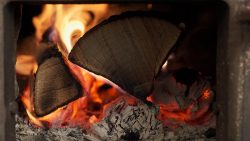Everything You Need to Know About Preparing Your Fireplace for Winter
November 8, 2023 2:09 pm Leave your thoughts
Safety First: Check for Damage
Before you do anything else, it’s crucial to inspect your fireplace and chimney for any signs of damage. Look for cracked or loose bricks, damaged mortar, and signs of water intrusion. Make sure your chimney cap and spark arrestor are in good condition. Any issues with the structural integrity of your fireplace or chimney should be addressed immediately to ensure safety during winter use.
Cleaning and Maintenance
A clean fireplace is not only more efficient but also safer to use. Start by removing any leftover ashes from the previous season. Use a shovel and brush to collect the ashes, and dispose of them in a metal container. Then, use a wire brush to scrub the interior of the fireplace to remove any soot and creosote buildup. Creosote is highly flammable, and its accumulation in the chimney can pose a fire hazard.
Inspect the Damper
The damper is a critical component that controls the flow of air and exhaust through your chimney. Ensure that it’s functioning correctly by opening and closing it. If it’s stuck or damaged, consider having it repaired or replaced. A properly functioning damper allows you to control the draft and prevents warm indoor air from escaping when the fireplace is not in use.
Chimney Inspection and Cleaning
A thorough chimney inspection is essential to identify any obstructions or creosote buildup that might be blocking the flue. It’s a good idea to have a professional chimney sweep perform an annual cleaning and inspection to ensure your chimney is clear and safe. They will also check for cracks or other damage that may not be immediately visible.
Check for Wildlife Nests
During the warmer months, animals may take refuge in your chimney or build nests. Birds, squirrels, and even raccoons can create blockages and pose a safety hazard. Inspect the chimney for any signs of nests or animals, and if you find any, contact a professional wildlife removal service to safely remove them.
Fireplace Accessories and Tools
Before winter sets in, make sure you have all the necessary fireplace accessories and tools in place. These include a sturdy fireplace grate, a set of fireplace tools (poker, tongs, shovel, and brush), and a fire screen or glass doors to contain sparks and embers. These tools not only enhance the safety and functionality of your fireplace but also add to the overall aesthetics of your hearth.
Stock Up on Firewood
It’s essential to have an ample supply of well-seasoned firewood on hand. Well-seasoned wood burns more efficiently and produces less creosote, reducing the risk of chimney fires. If you cut and store your own firewood, be sure it has had sufficient time to dry. For those who purchase firewood, ask the supplier about the wood’s moisture content to ensure it’s properly seasoned.
Proper Wood Storage
To keep your firewood dry and readily accessible, invest in a firewood rack or shed. Storing wood off the ground and in a well-ventilated area ensures it stays dry and ready to burn when you need it. Proper storage not only extends the lifespan of your firewood but also reduces the risk of pests or mold.
Inspect the Hearth and Surround
In addition to the fireplace itself, check the hearth and the area surrounding it. Ensure that there are no flammable materials or objects near the fireplace, as these can pose a fire hazard. If your fireplace has glass doors, inspect them for any cracks or damage, as this can affect the safety and efficiency of your fireplace.
Test Your Smoke and Carbon Monoxide Detectors
Fireplaces emit smoke and gases, so it’s crucial to have working smoke and carbon monoxide detectors in the vicinity. Test these devices to ensure they are functioning correctly and replace batteries as needed. Properly functioning detectors are a crucial safety measure when using a fireplace.
Consider an Annual Inspection
While many of the steps mentioned here can be done by homeowners, it’s a good idea to schedule an annual inspection with a certified chimney sweep. These professionals have the training and equipment to conduct a comprehensive inspection, clean the chimney thoroughly, and address any issues that may not be immediately visible to the untrained eye.
Keep an Eye on Local Regulations
It’s important to be aware of any local regulations or restrictions regarding the use of fireplaces. Some areas have specific rules about when and how fireplaces can be used, especially during air quality alert days. Be sure to stay informed about any local ordinances that may apply to your fireplace use.
Educate Yourself About Safe Burning Practices
If you’re new to using a fireplace, take the time to educate yourself about safe burning practices. Learn how to build and maintain a proper fire, including how to use kindling and arrange logs for optimal combustion. Proper fire-building techniques not only enhance safety but also improve the efficiency of your fireplace.
Summary
Preparing your fireplace for winter involves more than just lighting a fire. It’s a comprehensive process that begins with safety inspections and maintenance, extends to the storage of firewood, and includes the use of the right tools and accessories. By following these steps and staying vigilant about safety, you can enjoy the warmth and comfort of your fireplace throughout the winter season, knowing that it’s ready to provide both heat and ambiance.
Got Questions About Your Fireplace? Let Us Help!
Categorised in: Fireplace Maintenance, Fireplace Safety, Fireplaces
This post was written by admin
